“Agility is the ability to adapt and respond to change … agile organizations view change as an opportunity, not a threat.”
—Jim Highsmith
Organizational Agility
The Organizational Agility competency describes how Lean-thinking people and Agile teams optimize their business processes, evolve strategy with clear and decisive new commitments, and quickly adapt the organization as needed to capitalize on new opportunities.It is one of the seven core competencies of the Lean Enterprise, each of which is essential to achieving Business Agility. Each core competency is supported by a specific assessment, which enables the enterprise to assess its proficiency. These core competency assessments, along with recommended improvement opportunities, are available from the Measure and Grow article.
Why Organizational Agility?
In today’s digital economy, the only truly sustainable competitive advantage is the speed at which an organization can sense and respond to the needs of its customers. Its strength is its ability to deliver value in the shortest sustainable lead time, to evolve and implement new strategies quickly, and to reorganize to better address emerging opportunities.
Organizational agility is critical to respond sufficiently to the challenges. Unfortunately, the organizational structures, processes, and cultures of most businesses were developed more than a century ago. They were built for control and stability, not for innovation, speed, and agility. Small incremental changes to how businesses manage, strategize, and execute are insufficient to remain competitive. This requires a leaner and more agile approach which, in turn, requires sweeping changes that have a positive, long-lasting impact on the entire enterprise.
The SAFe approach to addressing the challenge of digital transformation is the ‘dual operating system’, (see Business Agility) one that leverages the stability and resources of the existing organizational hierarchy while implementing a value stream network that leverages the entrepreneurial drive still present in every organization. By organizing and reorganizing the enterprise around the flow of value instead of the traditional organizational silos, SAFe restores the second (network) operating system. It allows organizations to focus on both the innovation and growth of new ideas as well as the execution, delivery, operation, and support of existing solutions.
The organizational agility competency is instrumental in bringing the power of the second operating system to support the opportunities and threats of the digital age. This competency is expressed in three dimensions (Figure 1):
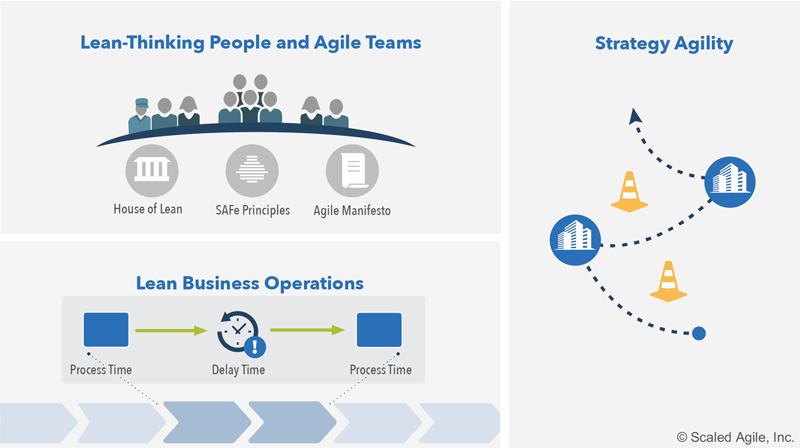
Lean-Thinking People and Agile Teams – Everyone involved in solution delivery is trained in Lean and Agile methods and embraces their values, principles, and practices.
Lean Business Operations – Teams apply Lean principles to understand, map, and continuously improve the processes that deliver and support businesses solutions.
Strategy Agility – The enterprise is Agile enough to continuously sense the market, and quickly change strategy when necessary.
Each of these dimensions is described in the sections that follow.
Lean-Thinking People and Agile Teams
Lean-thinking people and Agile teams is the first dimension of organizational agility. This dimension is critical to delivering business solutions—not just the software applications and digital systems, but all of the supporting activities (e.g., privacy, security, support, availability) necessary to continually address the business problem. Even the solution itself is not stand alone, it lives in the larger context of its environment—including other hardware, software, network systems, and more.
Figure 2 illustrates how everyone involved in the delivery of business solutions—operations, legal, marketing, people operations, finance, development, and others—can apply effective Lean and Agile methods and embrace the mindset, principles, and practices.
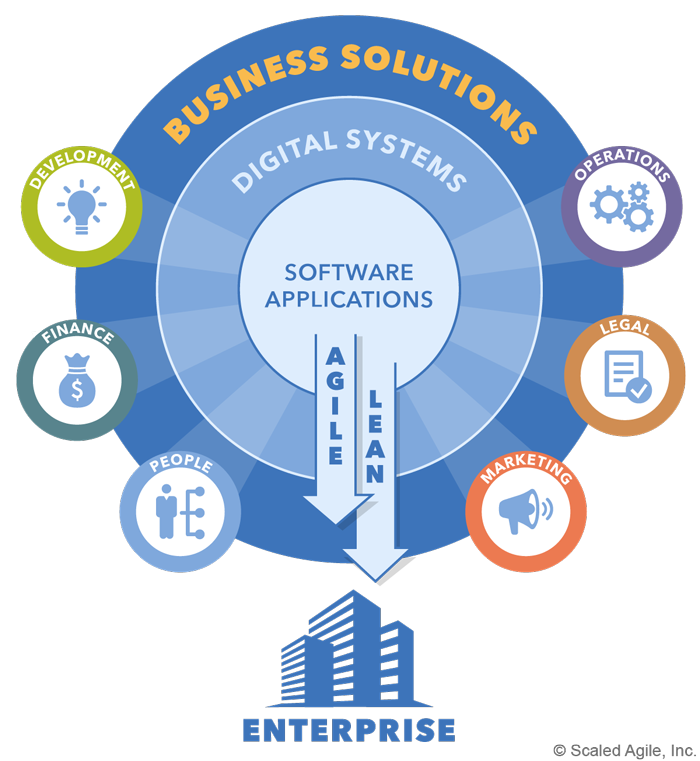
Extending the Mindset and Principles to the Enterprise
Extending the Lean-Agile mindset to the entire enterprise forms the cornerstone of a new management approach and results in an enhanced company culture that enables business agility. It provides leaders and practitioners throughout the enterprise with the thinking tools and behaviors needed to drive a successful SAFe transformation, helping individuals and the entire enterprise achieve their goals.
The Lean-Agile mindset establishes the right thinking, but it’s the ten underlying SAFe principles that guide effective roles, practices, and behaviors. These principles are fundamental to organizational agility and the Lean-thinking people and Agile teams who enable it. Everyone in the enterprise can apply these principles to their daily work, and thereby become part of the leaner, and more Agile, operating system.
Agile Technical Teams
As described in the Team and Technical Agility competency article, the emergence of Agile software development is fairly advanced and well understood. Now, with the advent of the DevSecOps movement, IT operations and security are also rapidly adopting Agile. Agile is also making its way to other technical domains, such as networking, operations (see DevOps), hardware (see Applying SAFe to Hardware Development), electronics, and more. After all, Agile technical teams typically achieve a degree of unprecedented performance and personal satisfaction with their work. Who doesn’t want to be on a high-performing Agile team?
Agile Business Teams
In addition, once the business understands this new way of working, it begins to recognize that the same benefits apply and typically starts creating cross-functional Agile business teams. These teams may be involved in any of the functions necessary to support developing and delivering business solutions, including the following:
- Sales, product marketing, and corporate marketing
- Sourcing and supply chain management
- Operations, legal, contracts, finance, and compliance
- People operations (Agile HR)
- Receiving, production, fulfillment, and shipping
- Customer service, support, and maintenance
As Agile business teams begin to form, we’ve often observed a ‘three-step maturity cycle’ which illustrates how they form and mature the practices that are particular to their domain. (Figure 3):
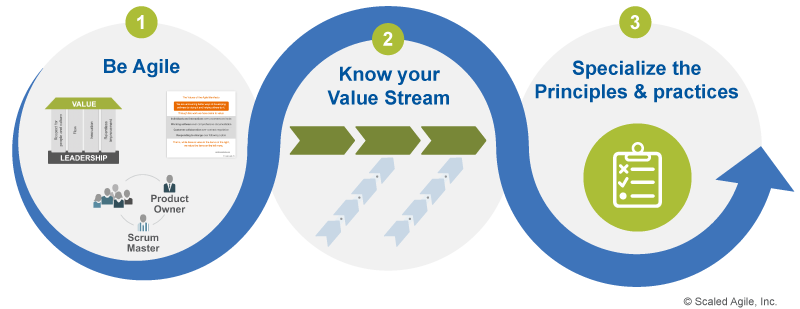
The Business and Technology article describes the maturity cycle in more detail and also provides some context for how the industry is starting to apply agility in other business domains.
Agile Working Environments
In addition to more contemporary HR practices, experience and research have shown that working environments and physical spaces support highly productive Agile teams [2]. Physical space considerations include:
- Providing focused individual areas that enhance the state of mental flow
- Supporting the need for constant informal team collaboration
- Supporting the need for occasional privacy
- Providing room for Daily Stand-ups, whiteboards, and walls to post objectives
In addition, PI planning is a critical event in SAFe. As such, a semi-dedicated physical space for PI planning is recommended and will pay for itself over time. This topic, including some recommendations for physical space design and accommodations, is further described in the advanced topic article, Agile Workspaces: Facilities that Enhance Business Agility.
In addition, at the time of this writing, COVID-19 has created an extreme situation where most employees are required to work remotely. For some organizations, this event has significantly altered the preconception that Agile teams must be physically located in an office and it has already demonstrated that they can be highly productive even in a remote setting. However, the organization must ensure that everyone has the requisite infrastructure and technology to support remote working which includes:
- High bandwidth connection for audio and video communication
- Adequate computer hardware including webcams and headsets
- Out-of-hours technical support, covering all required time zones
- Access to files via a remotely accessible storage solution
- Instant messaging, collaboration, and Agile Lifecycle Management tooling
More information and further guidance is provided in the advanced topic article, Working Successfully in Agile with Remote Team Members. Additionally, Distributed PI Planning with SAFe provides recommendations for ensuring the right working environment for a successful remote PI Planning event.
Visualizing Work
“In a lean organization, we want people to see the effect of their work so that we don’t have to tell them what to do.” — Alan Ward.
Frequently, during various SAFe training forums, attendees ask, “But if I was to leave here and do only one thing to start implementing Lean-Agile development at scale, what would it be?” Our answer is always the same: visualize the work. That is why when you visit an Agile enterprise, you see work everywhere—on walls, whiteboards, desktops, monitors, hallways, and wherever you look. Visualization converts the abstract to tangible; flushes out unnecessary, unplanned, unapproved, or duplicate work; and aligns everyone to the actual current state.
The common thread across all these approaches is that the information is always available: no effort is needed to go and discover it. Based on our experiences, we’ve recommended some starting points:
- Visualize customers. Agile teams use personas to bring the customer to life and post their representations on the walls of their team area, so they are always top of mind.
- Visualize the flow of work. Making the current work visible using Kanban systems exposes the amount of Work In Process (WIP), bottlenecks, and what people are really doing as opposed to what others think they are doing.
- Visualize solution health. Customer support teams have long seen the value in displaying the number of waiting calls, daily closed and open tickets, and current Service Level Agreements performance prominently on monitors close to the teams who rely on that information. This approach has been adopted by Agile teams to include metrics on the state of the current solution.
- Visualize strategy. Another example of visualizing work is an ‘investment corridor’ (Figure 4) that identifies all current and potential epics in flight. Rather than confining the portfolio visualizations to a room, information in the corridor is outside, making it easy for people to walk up and add their thoughts and suggestions.
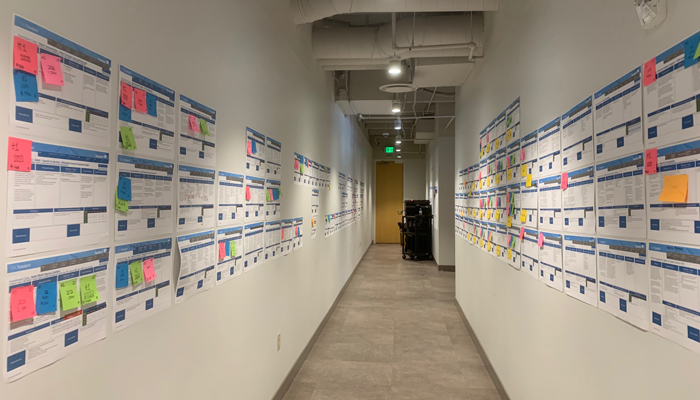
Lean Business Operations
Lean business operations is the second dimension of organizational agility. Organizational agility requires enterprises to understand both the Operational Value Streams (OVS) that deliver business solutions to their customers, as well as the Development Value Streams (‘DVS’, which are the primary focus of SAFe) that develop those solutions.
Figure 5 illustrates the relationship between operational and development value streams.
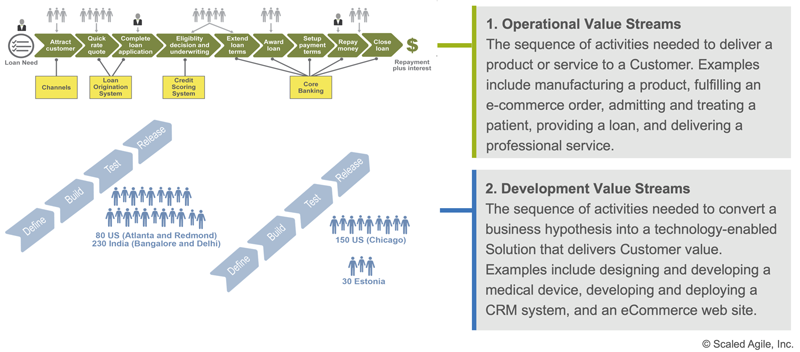
For many developers, the people who run the operational value streams are the customers of the development value streams. They directly use, operate and support the solutions that support the flow of value to the end-user. This requires that developers:
- Understand (and often help analyze and map) the operational value streams they support
- Apply customer-centricity and design thinking to internal and external solutions
- Include the business teams that support the solution in the development process
These responsibilities help assure that the business solutions developed provide a ‘whole-product solution’ to satisfy the needs of both internal and external customers.
Mapping Value Streams
“Lean companies focus on value streams to eliminate non-value-creating activities. Good development systems consistently create profitable (operational) value streams.” —Alan Ward
Identifying operational and development value streams is a critical task for every Lean enterprise. Once identified, value stream mapping is used to analyze and improve business operations [4]. Figure 6 illustrates a simplified example of value stream mapping, which, in this case, shows a few of the steps in a marketing program launch.

Teams look for the opportunity to improve the efficiency of each step, consequently reducing the total lead time. This includes reducing process time, as well as improving the quality of each step measured by the percent complete and accurate. (The percent complete and accurate represents the percentage of work that the next step can process without it needing to go back for rework.)
As is the case in the figure above, the delay time (the waiting time between steps) is often the biggest source of waste. If the team above wanted to deliver a marketing campaign faster, they would need to reduce the delay times, as the processing steps are only a small part of the total lead time. Reducing delays is typically the fastest and easiest way to shorten the total lead time and improve time to market.
Implementing Flow
In addition to mapping the value stream, the entire process can be visualized with a Kanban system as a means to continuously improve performance and identify bottlenecks. SAFe Principle #6, Visualize and limit Work In Process (WIP), reduce batch sizes, and manage queue lengths, is then applied to optimize flow. Figure 7 illustrates a simplified Kanban system for a set of marketing campaigns associated with a major product launch.
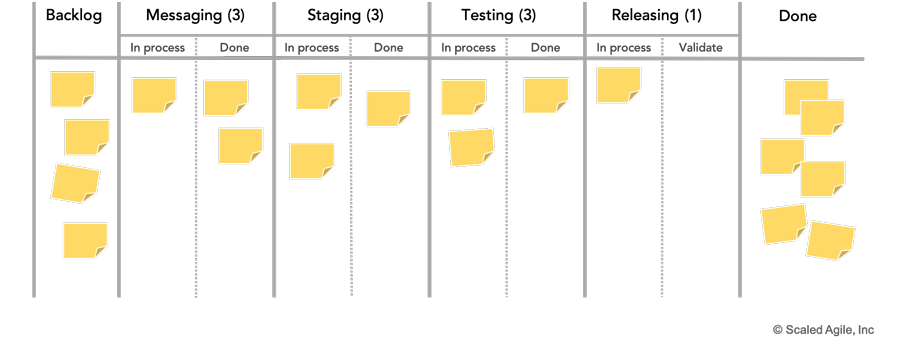
Each marketing campaign, represented by a card, works its way through the system from the backlog to done. WIP limits (the numbers in parentheses in Figure 7) help control the amount of work in the system.
Optimizing Operational Value Streams with Tooling and Automation
The increasing complexity and importance of software development have led the entire industry down the Agile path. While some of the lessons learned are specific to software (software is ‘soft’ after all, the laws of physics don’t seem to apply so directly), many more of the lessons do. One critical lesson is the value of automation in managing the extraordinary complexity of millions of lines of code that are constantly being updated, recompiled, and redistributed. To address this, DevOps focuses heavily on identifying and version controlling all the artifacts and automating as many steps in the workflow as possible.
That lesson applies equally well to the work items that move through the OVS, which are also increasingly digital and intangible. To that end teams responsible for improving operational value streams invested in applying or developing the tooling automation they need to make the process more efficient, and to better support an increasingly distributed and work-from-home workforce. This tooling typically includes:
- Agile Lifecycle Management solutions instantiate and connect the various backlogs and Kanbans teams use to manage their local work and provide enterprise-wide visibility
- Collaboration tools support local and distributed development and the intense degree of interaction and cooperation that is required
- Content management and translation management systems help teams of all type store, revise, access, and translate content
- Workflow management systems help business teams visualize and track the activities to evolve an ever-increasing set of digital assets
Tooling also provides the enterprise with the opportunity to measure and improve these processes. Moreover, Lean-Thinking people and Agile teams have specific training and insights on how work flows through the system. They understand that optimizing one activity does not optimize the whole and that delays in the process (see ‘mapping value streams’ below) have far more impact than the efficiency of any one step.
To combat this, Agile enterprises connect these tools to create an integrated toolchain or ‘tool network’ [3]. Only then will they be able to see the work as it flows through the system and to identify bottlenecks and opportunities for improving the entire value stream.
Strategy Agility
Strategy agility is the third dimension of the organizational agility competency. Strategy agility is the ability to sense changes in market conditions and implement new strategies quickly and decisively when necessary. It also includes the good sense to persevere on the things that are working—or will work—if given sufficient time and focus. Figure 8 illustrates how strategy must respond to market dynamics to successfully realize the enterprise’s mission.
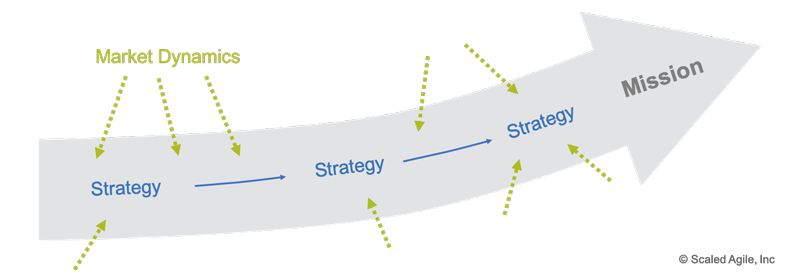
Enterprises that have mastered strategy agility typically exhibit a number of capabilities, including those described in the following sections.
Market Sensing
Market sensing represents the culture and practice of understanding changing market dynamics based on the following:
- Market research
- Analysis of quantitative and qualitative data
- Direct and indirect customer feedback
- Direct observation of the customers in the marketplace
Savvy, Lean-thinking leaders ‘go see’ and spend significant time in the place where the customer’s work is actually performed. They return with current, relevant, and specific information about the realities of their products and services, instead of opinions filtered through other perspectives.
Innovating Like a Lean Startup
After sensing opportunities, the Lean enterprise visualizes and manages the flow of new initiatives and investment by adopting a ‘build-measure-learn’ Lean startup cycle. These initiatives are often new business solutions, but they may also be new business processes and capabilities that use existing solutions. Testing the outcome hypothesis via a Minimum Viable Product (MVP) before committing to a more significant investment reduces risk while generating useful feedback.
Implementing Changes in Strategy
Identifying and defining a new strategy is only the first step. Once determined, the strategy must be communicated to all stakeholders in a new vision and roadmap and then, of course, be implemented. After all, significant changes to strategy often affect multiple solutions in the portfolio and require coordination and alignment. Consequently, most large strategy changes require new epics to implement the change across value streams.
Figure 9 illustrates how new epics go through the various Kanban systems and backlogs that manage the flow of work. During the normal course of work all backlogs are continuously reprioritized. Kanban systems help changes in strategy move quickly across value streams to the teams who do the implementation. This way, execution is aligned—and constantly realigned—to the evolving business strategy.
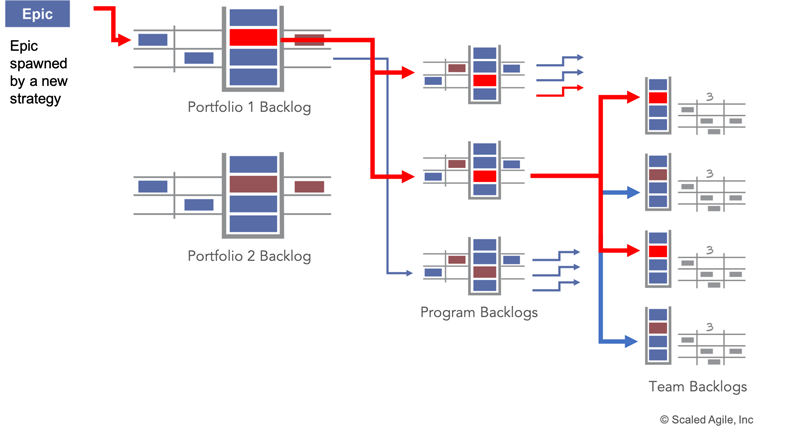
However, other smaller, local changes may require only new stories or features and will go directly in the team or program backlogs.
Innovation Accounting
It can take a long time to evaluate the benefits of a change in strategy. Traditional financial and accounting metrics Profit and Loss (P&L) and Return On Investment (ROI) are lagging economic indicators that occur too late in the life cycle to inform the evolving strategy. In their place, Innovation Accounting applies leading indicators—actionable metrics focused on measuring specific early outcomes using objective data. They are an essential part of the economic framework that drives business agility.
Ignoring Sunk Costs
A key factor in strategy agility is ignoring sunk costs, the expenses that have already occurred in the course of solution development. Sunk costs cannot be recovered or changed and are independent of any future costs a company may incur [5]. Because strategic decision-making affects only the future course of business, sunk costs are absolutely irrelevant when evaluating a change in strategy. Instead, decision-makers should base all strategy decisions solely on the future costs of the initiatives necessary to achieve the change. When stakeholders do not have to waste energy to defend past spending, the organization can pivot more quickly to a new strategy.
Organizing and Reorganizing Around Value
Finally, SAFe Principle #10 – Organize around value guides enterprises to align their development efforts around the full, end-to-end flow of value. This principle highlights the ‘dual operating system,’ one that leverages the benefits of the existing hierarchy but also creates a value stream network (Figure 10 below). This network assembles the people who need to work together, aligns them to the needs of the business and customer, minimizes delays and handoffs, and increases quality.
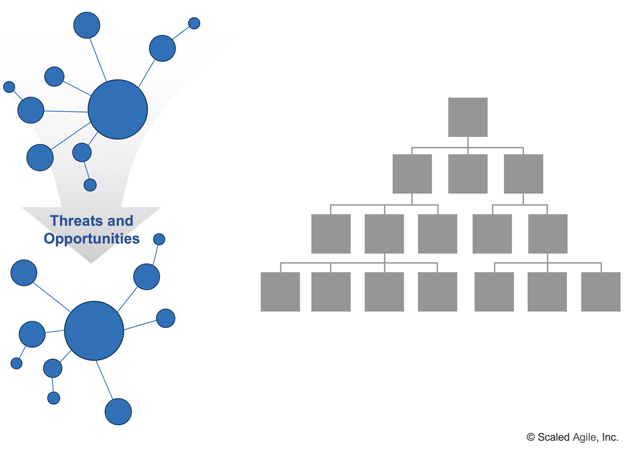
But as strategy moves, future value moves with it; new people and resources must be applied. In other words, some degree of reorganization is required. Indeed, in some cases, this will require entirely new value streams be formed to develop and maintain new solutions. Other value streams may need to be adjusted, and some will be eliminated entirely as solutions are decommissioned. Fortunately, the people and teams of an increasingly Agile enterprise see those changes coming through the portfolio. They can then use their new knowledge and skills to reorganize Agile teams and ARTs around value whenever it makes sense.
Agile Contracts
No portfolio is an island. Instead, each typically depends on other portfolios, suppliers, partners, operational support, and more, all of which require implicit or explicit contracts for the value to be delivered. Traditionally, these contracts are based on the assumption that requirements, deliverables, and service levels are known upfront and will remain stable. We know from experience that is just not true. As strategy changes, these traditional contracts can become enormous impediments that lock the business into assumptions of a former strategy. Although the business would like to change strategy, it is blocked by existing contracts.
Achieving business agility requires a more flexible approach to all types of contracts. How this is achieved depends on the nature and type of contract, but each must be considered in terms of the adaptability that may be required as strategy evolves. Contracts for suppliers that provide components, subsystems, or services for enterprise solutions are particularly critical as they may tend to lock solution elements into requirements that were fixed long before. The Agile Contracts advanced topic article provides guidance on contracting strategies that can provide the needed flexibility,
Summary
Without organizational agility, enterprises can’t react fast when things happen. To be fully responsive to threats and opportunities requires Lean and Agile ways of working to spread throughout the entire organization. This change demands a workforce that is not only trained in Lean-Agile practices, but one that understands and embodies the culture, values, and principles.
Lean business operations recognize that delighting customers goes further than purely solution development. The entire customer journey, which includes delivering, operating, and supporting business solutions, needs to be continually optimized to reduce time to market and increase customer satisfaction. Strategy agility provides the ability to sense and respond to changes in the market, to evolve and implement new strategies quickly, and to reorganize when necessary to address emerging opportunities. As a result, ‘change becomes an opportunity, not a threat.’
Learn More
[1] SAFe for Marketing whitepaper [2] Hesselberg, Jorgen. Unlocking Agility: An Insider’s Guide to Agile Enterprise Transformation. Addison-Wesley Signature Series (Cohn). Pearson Education, 2018. [3] Kersten, Mik. Project to Product. IT Revolution Press, 2018. [4] Martin, Karen. Value Stream Mapping: How to Visualize Work and Align Leadership for Organizational Transformation. McGraw-Hill Education, 2013. [5] https://www.investopedia.com/ask/answers/042115/why-should-sunk-costs-be-ignored-future-decision-making.asp
Last updated: 27 September 2021





